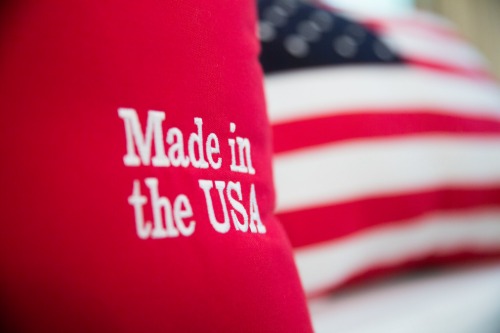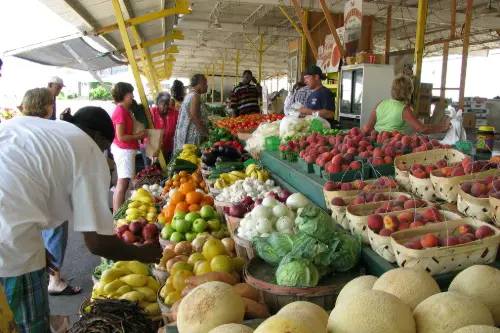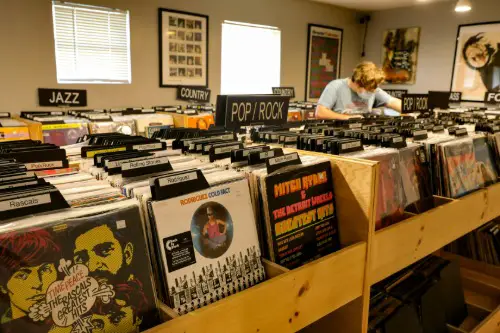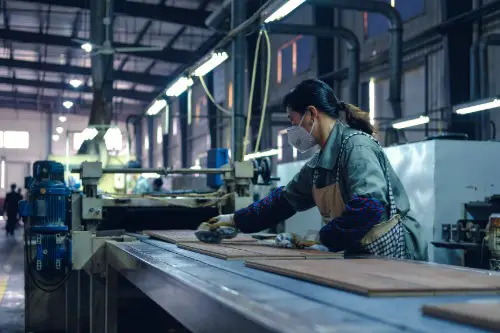1. Textile and Garment Manufacturing

Textile and garment manufacturing is making a surprising comeback in the U.S. after decades of decline due to outsourcing. This resurgence is driven by a mix of factors, including increased demand for sustainable, American-made clothing and geopolitical tensions that have disrupted global supply chains, according to Apparel Resources. Brands are realizing the benefits of reshoring their operations, especially in regions like the Carolinas, where textile mills are being revitalized.
Consumers are willing to pay more for ethically made clothing, and this shift is encouraging brands to prioritize quality and transparency over fast fashion. Plus, the rise of tech-enhanced fabrics—like antimicrobial or eco-friendly materials—is giving U.S. manufacturers a competitive edge. As American factories modernize, they’re proving that “Made in the USA” can mean cutting-edge and sustainable.
2. Domestic Farming

America’s agricultural industry is seeing a revival, especially small-scale and family-owned farms. Thanks to the growing popularity of farm-to-table dining and sustainable practices like regenerative agriculture, more consumers are seeking locally grown food. Farmers’ markets are bustling, and direct-to-consumer models, where people can order fresh produce online and have it delivered, are thriving.
Government support has also played a role in this comeback, with grants and subsidies aimed at encouraging environmentally friendly practices, USDA.gov explains. Younger generations, some inspired by the homesteading trend on social media, are embracing farming as a lifestyle, bringing innovation and new energy to the sector. From urban rooftop farms in New York City to organic dairies in Wisconsin, American farming is getting its groove back.
3. Independent Bookstores

Independent bookstores in America are enjoying a renaissance, driven by a growing demand for authentic community spaces. As e-books and online retail took over, many thought indie shops were doomed, but they’ve proven incredibly resilient, according to The New York Times. In 2025, they’re thriving by offering much more than books: think local author talks, vibrant book clubs, and even hybrid events that cater to online audiences. These stores have become cultural hubs, connecting people in an increasingly digital world.
Younger generations, especially Gen Z, are big on supporting local businesses, and bookstores have capitalized on this loyalty. Social media, especially TikTok, has also played a surprising role in the resurgence, with “BookTok” driving massive sales for specific titles. Meanwhile, indie stores are partnering with small publishers to bring unique, diverse voices to their shelves. The combination of community focus, nostalgia, and savvy marketing has made these bookstores essential to American culture once again.
4. Vinyl Records

The U.S. vinyl record industry is booming, proving that physical music isn’t just a thing of the past. In 2025, vinyl records are outselling CDs and becoming a go-to format for music fans who crave a tangible connection to their favorite artists, according to CNBC. This revival has been fueled by both nostalgia and the younger generation’s discovery of the warm, rich sound of analog music.
American artists and record labels are responding with limited-edition vinyl releases, complete with stunning album art and collectible features. Pressing plants in cities like Nashville and Cleveland are running 24/7 to keep up with demand, and independent record stores are thriving. The resurgence isn’t just a niche interest anymore—it’s become mainstream, with even major retailers like Target stocking vinyl collections.
5. Craft Breweries

Craft breweries in America are experiencing a second golden age in 2025. After a slight decline in recent years due to market saturation, many small brewers have reinvented themselves by focusing on hyper-local flavors and unique brewing techniques. Breweries have become community gathering spots, offering events like trivia nights, live music, and beer yoga (yes, that’s a thing).
Consumers are increasingly opting for quality over quantity, and craft beer fits the bill perfectly, according to Forbes. Breweries are also embracing sustainability by sourcing local ingredients and finding innovative ways to reduce waste. This new wave of craft brewing is all about creativity, from hazy IPAs to sour ales infused with regional fruits, and Americans can’t get enough.
6. U.S. Manufacturing

While manufacturing in the U.S. has been in decline for years, 2025 is shaping up to be a turning point. Companies are reshoring production to avoid overseas supply chain issues and rising transportation costs. From electronics to automotive components, American factories are ramping up production to meet growing demand.
The adoption of advanced manufacturing technologies, like robotics and AI, has made U.S.-based production more competitive globally. States like Michigan, Ohio, and Indiana, once hit hard by the decline of manufacturing, are seeing a surge in job opportunities and investment. It’s not just about reviving old industries—it’s about creating the factories of the future.
7. Electric Vehicle Manufacturing

Electric vehicle (EV) manufacturing is surging in the U.S., transforming once-struggling auto towns like Detroit and Chattanooga. Major automakers, including Ford, GM, and Tesla, are heavily investing in American EV plants to meet skyrocketing demand for sustainable transportation. Government incentives, like EV tax credits, are accelerating this shift, along with new federal investments in battery technology.
American innovation is driving this comeback. From cutting-edge solid-state batteries to advanced AI-powered driving systems, the U.S. is emerging as a global leader in EV tech. Startups and legacy manufacturers alike are creating jobs, boosting local economies, and laying the groundwork for a greener future.
8. Paper and Packaging

The U.S. paper and packaging industry is having an unexpected revival, thanks to the global push to reduce single-use plastics. As companies switch to sustainable alternatives, the demand for paper-based packaging has soared. American mills, especially those focused on recycled materials, are working overtime to meet the growing need for eco-friendly options.
This shift is part of a larger movement toward circular economies, where materials are reused instead of discarded. Innovations like biodegradable coatings and compostable packaging have made paper products a viable replacement for plastics in everything from takeout containers to e-commerce packaging. It’s a great example of how environmental challenges can spark industry growth.
9. Solar Panel Production

With clean energy goals gaining momentum, solar panel manufacturing in the U.S. is booming in 2025. Companies like First Solar and Qcells are expanding domestic production, reducing reliance on imported panels from countries like China. Federal tax credits and investments in renewable energy infrastructure are making it more cost-effective to manufacture solar panels right here in America.
This resurgence is creating jobs in regions like Georgia and Arizona, where new factories are springing up. The focus isn’t just on quantity but also on quality, with American manufacturers producing more efficient, longer-lasting panels. It’s a win for the environment and the economy.
10. Film Photography

Film photography has captured America’s imagination once again, with demand for 35mm and medium-format film skyrocketing. Companies like Kodak, headquartered in Rochester, New York, are doubling down on production to keep up with demand. Film schools and photo labs across the country are seeing a revival, too, as people rediscover the magic of analog photography.
For many, film offers a creative process that digital photography just can’t replicate. Younger generations, in particular, are drawn to the nostalgic aesthetic and the slower, more intentional approach to photography. This resurgence has turned film cameras—once consigned to thrift stores—into sought-after treasures.
11. Domestic Fisheries

America’s fishing industry is bouncing back, thanks to a renewed focus on sustainable practices and local sourcing. With more Americans prioritizing fresh, local seafood over imported options, fisheries in places like Alaska, Maine, and the Gulf Coast are seeing a surge in demand. Government policies aimed at protecting marine ecosystems have also helped rebuild fish populations, ensuring the long-term viability of the industry.
Restaurants and grocers are working directly with fishermen, cutting out middlemen and offering fairer prices. Meanwhile, consumers are becoming more adventurous, embracing lesser-known but sustainable options like Atlantic pollock and Arctic char. This comeback is a win for coastal communities and the environment.
12. American Wool Production

The American wool industry is enjoying a revival in 2025, as consumers look for sustainable, natural, and durable fabrics. Wool had declined for decades due to synthetic fibers and outsourcing, but it’s now making a big comeback, particularly in fashion and outdoor gear. Ranches in states like Montana, Wyoming, and Colorado are experiencing a surge in demand as more brands commit to sourcing ethically and locally produced wool.
Part of this resurgence comes from the rise in popularity of American-made products and the farm-to-fashion movement. Younger designers are embracing wool for its versatility, biodegradability, and insulating properties. Additionally, wool is becoming a go-to material in technical gear, as brands blend it with innovative fabrics to make everything from hiking socks to weather-resistant jackets. Wool is proving that it’s not just timeless—it’s forward-thinking.
13. U.S.-Made Furniture

American-made furniture is back in the spotlight as consumers prioritize quality over mass-produced imports. Craftsmanship and sustainability are driving this resurgence, with small and mid-sized workshops popping up across the country, from Amish artisans in Pennsylvania to modern design studios in California. People want furniture that lasts decades, not months, and they’re turning to local makers to deliver that durability.
Supply chain issues in recent years also pushed consumers and businesses to rethink their reliance on overseas manufacturing. This shift has allowed U.S. furniture makers to thrive, offering not only high-quality goods but also customization options that global competitors can’t match. Plus, many Americans are drawn to the idea of buying from brands that support local jobs and use sustainably sourced materials. This renewed focus on craftsmanship is bringing heritage industries back into the modern home.


